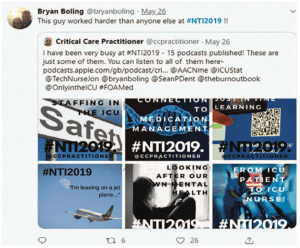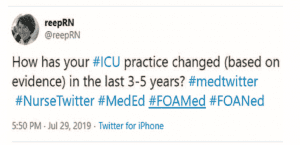Access learning online.
EDITOR’S NOTE: This article will appear in an upcoming issue of American Nurse Journal.
The internet and social media, which have revolutionized every aspect of our lives, have become especially important since the onset of the COVID-19 pandemic. For example, online learning has replaced traditional classroom settings for the near future. But even before the current crisis, our dependence on traditional sources, such as textbooks and print journals, was waning. Both are valuable and useful, but they can be expensive, and delays inherent in traditional publishing make them difficult to keep updated. One resource for online learning—Free Open-Access Medical (FOAM) education—that’s pertinent to nurses and other healthcare professionals is worth examining.
What is FOAM?
Free open-access means online content related to research findings is available at no cost to anyone. It’s not a new concept (sharing and collaborating is common among professionals), but it was codified in 2012 by a group of emergency medicine physicians who wanted to change the negative connotations of social media and online sources in their colleagues’ minds.
FOAM isn’t a website; it’s medical information shared across many platforms, including blogs, podcasts, and social media sites such as Twitter and YouTube. FOAM also reflects a philosophy: To provide accurate scientific information and clinical expertise to anyone who wants it, without cost or bias. Whether you’re a student, a practicing nurse looking to stay up-to-date on current practice, or an educator seeking new tools to improve student learning, the FOAM community’s concepts and tools can be used to enhance learning.
Benefits
Many healthcare professionals distrust social media and online content. Just as a car in an inexperienced driver’s hands can be dangerous, so can social media. But in an experienced driver’s hands, that same car provides access to employment and the wider world. The FOAM creators view social media, in experienced hands, as a trustworthy vehicle for information sharing and collaboration. Joe Lex, an emergency medicine physician and educator who creates content for and uses FOAM, said, “If you want to know how we practiced medicine 5 years ago, read a textbook. If you want to know how we practiced medicine 2 years ago, read a journal. If you want to know how we practice medicine now, go to a (good) conference. If you want to know how we will practice medicine in the future…use FOAM.” Nursing has embraced the concept as well, sometimes using the acronym FOAN (N for Nursing).
Low cost
All of us want to stay on top of the latest developments in nursing, but most of us don’t have an unlimited budget for books, journals, and conferences. So, the “free” part of FOAM is particularly appealing. Many FOAM resources are available at no cost, allowing access to quality educational materials without breaking your budget. And just because a resource has a cost associated with it doesn’t mean you should bypass it. Many deliver high-quality content at a cost that’s still lower than more traditional sources. Evaluate each resource independently to see if the cost is worth it to you.
Asynchronous learning
Inflexible scheduling is another significant limitation of traditional education; ask any night shift nurse how he or she feels about mandatory daytime classes. In addition to work, we have responsibilities to family and friends, as well as other interests that occupy our time. Asynchronous learning allows you to set the schedule. With recorded audio or video, you can listen to or watch content at a time that’s best for you rather than working around a classroom schedule. This concept is already embraced by traditional nursing education in online or hybrid programs.
Just-in-time learning
Nurses frequently face unfamiliar situations in patient care. Although educators assess competency each year, some procedures or equipment will remain unfamiliar due to low use. But what happens when you find yourself needing that knowledge? Just-in-time learning provides education exactly when you need it (and are motivated to learn). For example, just-in-time learning can be used to teach a home care nurse who has not recently cared for a patient with an indwelling infusion port the proper way to access it.
Search Twitter.com for hashtags (terms proceeded by #) to find content of interest.


Many conferences have a hashtag before their name so those not in attendance can access information, promote the conference, and participate in discussions.


To help users find your tweets, use multiple hashtags with common search terms.
Potential challenges
Despite the numerous benefits to incorporating FOAM into both traditional nursing and clinical continuing education, challenges exist. The biggest issues are deciding what resources to trust, avoiding common problems inherent to self-directed learning, maintaining online professionalism, and accepting the lack of continuing education credit.
Trust
FOAM content has been criticized for lack of peer review. Some feel that FOAM resources don’t receive the rigorous scrutiny of traditional publications, so they can’t be trusted. One of the major benefits of FOAM is that almost anyone can start a blog or podcast or share on social media. But this low barrier to entry allows participation in the exchange of ideas without the dual gatekeepers of peer review and professional editing, and those accessing material may believe all content is of equal merit.
However, this is true for any source. We frequently assume that publishers and the peer-review process will prevent fraud and misinformation. But several high-profile journals have had to retract articles that were later shown to be false, and respected universities have been humbled by scientific research fraud. Even articles that aren’t fraudulent but have significant methodological flaws find their way into trusted journals.
When evaluating a resource, check for the name of an author (preferably with credentials and contact information); anonymous resources should be viewed with suspicion. Also look for a publication date to ensure information is current, and review listed references for validity. Evidence-based resources carry more weight than “expert opinions.”
To help readers determine content accuracy, many FOAM resources receive immediate online “peer review” via real-time feedback and heated debates on Twitter or in the comments section of a blog. Members of the FOAM community aren’t afraid to point out bad science. In addition, FOAM doesn’t present itself as separate from traditional sources but rather as an adjunct. Because most people aren’t able to read even a fraction of the articles that pertain to their profession, FOAM’s online community serves as a space for information sharing, discussion, and application.
Self-directed learning
The lack of a formal curriculum in self-directed learning can be challenging for some. Formal educational programs develop curriculum where instructors decide what concepts are important for students to learn. When learning is self-directed, you may walk away with disjointed facts. And you may be tempted to focus on the newest, coolest topics while ignoring the more mundane, but essential ones. For example, search for FOAM articles about extracorporeal membrane oxygenation and you’ll find a long list of blogs and podcasts. But when you search for infection prevention, you’ll find comparatively few resources, even though we know that simple practices, such as handwashing, can have a major impact on health.
You’ll also need to perform an honest assessment of your knowledge gaps. Studying material you already know will be easier and more fun, but you’ll need to find time for subjects you’re less familiar with.
Professionalism
Any discussion of online learning and social media would be incomplete without considering professionalism. The relative anonymity offered by social media may tempt you to say things you wouldn’t in a face-to-face discussion with a colleague. Also, inadvertently violating a patient’s privacy or making comments that might get you into trouble with your employer or the board of nursing is surprisingly easy. The National Council of State Boards of Nursing has published an excellent resource—A Nurse’s Guide to the Use of Social Media—that addresses online professionalism.
Continuing education credit
Most online and social media offerings don’t offer continuing education credit, something that many formal programs do provide. Keep this in mind when planning your annual education. Because FOAM offerings are free, you can allocate funds for programs that offer credit.
Getting started
Twitter is a great place to get started with FOAM. It provides a unique forum for conversations about professional topics that matter to you. On Twitter, a hashtag (#) before a word will help you find tweets about a topic. Many people use #FOAM (or #FOAMed) to identify their tweets with the concept. And many conferences have a hashtag before their name so that those not in attendance can access information and elevate the the conference’s influence. Hashtags also can be helpful in identifying your tweet so that others can find it. You can use multiple tags to help those searching for information find it using expected terms, such as #ICU or #infectionprevention. (See #Hashtag.)
Twitter also offers nurses the opportunity to interact more formally with other nurses or with an interdisciplinary team using scheduled chats. Kelley Reep (coauthor of this article) cohosts #TweetRN, a weekly chat for nurses discussing issues such as burnout, LGBTQ matters, interdisciplinary relationships, and nurses’ absence in mainstream media. For more information about getting started with Twitter, visit Mom This Is How Twitter Works and A Nurse’s Guide to Twitter.
If you’re wondering who to follow on social media, start by searching for your favorite nursing organizations (for example, the American Association of Critical-Care Nurses, the American Nurses Association, or the Emergency Nurses Association). Also look at who your colleagues are following and follow us (@bryanboling and @reepRN on Twitter) to see who we’re following. (See A few favorites.)
Here are a few of our favorite blogs, podcasts, and Twitter chats.
Blogs and podcasts
- CriticalCarePractitioner (Jonathan Downham)
- Life in the Fast Lane
- FreshRN (Kati Kleber)
- Q Word Podcast (emergency nursing)
- Resus Tonight podcast
- Chief Complaint Podcast
- Critical Care Scenarios (Brandon Oto and Bryan Boling)
Twitter chats
- #TweetRN (all nurses and students): Weekly, Monday 9 pm Eastern
- #NPchat (nurse practitioners): Weekly, Tuesday 8 pm Eastern
- #WeNurses (nurses UK)
- #whywedoresearch (nurse research)
- #TwitticalCare (nurses, nurse practitioners, and other critical care providers): Weekly, Thursday 9 pm Eastern
Manage the challenges, reap the benefits
Keeping current with the rapid changes in healthcare is challenging for nurses, but good practice requires it. To meet that need, undergraduate and graduate nursing education must adapt to new technologies and methods of information sharing. FOAM provides benefits that allow nurses to manage their continuing education while saving money and working around their busy schedules. Challenges exist, but they’re manageable. And the benefits far outweigh any downsides to these innovative learning tools.
Bryan Boling is an advanced practice provider in anesthesia critical care at the University of Kentucky in Lexington and adjunct faculty in the acute care nurse practitioner program at Georgetown University in Washington, DC. Kelley Reep is a clinical nurse specialist at WakeMed Health and Hospitals in Raleigh, North Carolina.
References
Berlatsky N. Why isn’t academic research free to everyone? The Atlantic. November 19, 2014. theatlantic.com/technology/archive/2014/11/why-isnt-academic-research-free-to-everyone/382917
Cadogan M. FOAM. Life in the Fastlane. September 14, 2019. litfl.com/foam-free-open-access-medical-education
Carroll CL, Bruno K, vonTschudi M. Social media and free open access medical education: The future of medical and nursing education? Am J Crit Care. 2016;25(1):93-6.
Grock A, Paolo W. Free open access medical education: A critical appraisal of techniques for quality assessment and content discovery. Clin Exp Emerg Med. 2016;3(3):183-5.
Jackson J, Mitchell R. Day in the life: Live tweets as a professional tool. Am Nurse Today. 2015;10(6). myamericannurse.com/day-life-live-tweets-professional-tool
Lex JR. International EM education efforts & E-learning. Recorded August 2012 in New York City. freeemergencytalks.net/wp-content/uploads/2012/08/2012-08-21-08h00-International-EM-Education-Efforts-E-Learning.mp3
McCabe K. Understanding Twitter chats—A guide to start & join the conversation. August 2018. raventools.com/blog/understanding-twitter-chats
McNamara P. A nurse’s guide to Twitter. acrobatant.com/a-nurses-guide-to-twitter
Mom This Is How Twitter Works. momthisishowtwitterworks.com.
National Council of State Boards of Nursing. A Nurse’s Guide to the Use of Social Media. June 2018. ncsbn.org/NCSBN_SocialMedia.pdf
Rezaie S. From Hippocrates to Osler to FOAM. RebelEM. April 4, 2014. rebelem.com/hippocrates-osler-foam
Roland D, Spurr J, Cabrera D. Preliminary evidence for the emergence of a health care online community of practice: Using a netnographic framework for Twitter hashtag analytics. J Med Internet Res. 2017;19(7):e252.
Tunnecliff J, Weiner J, Gaida JE, et al. Translating evidence to practice in the health professions: A randomized trial of Twitter vs Facebook. J Am Med Inform Assoc. 2017;24(2):403-8.
Twitter. How to use hashtags. help.twitter.com/en/using-twitter/how-to-use-hashtags


















